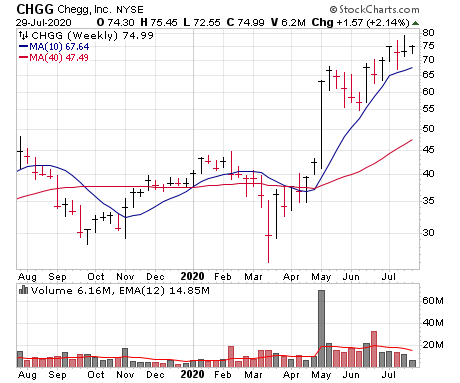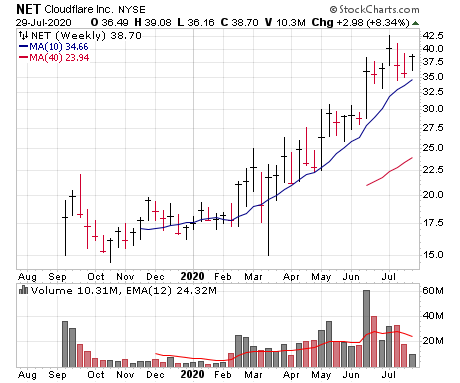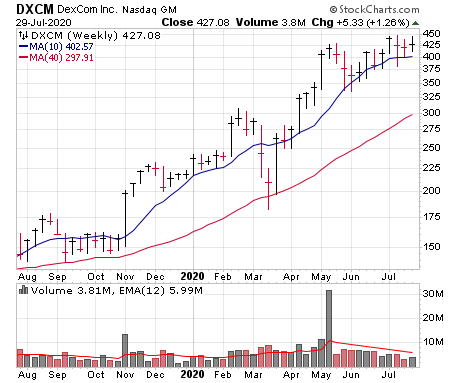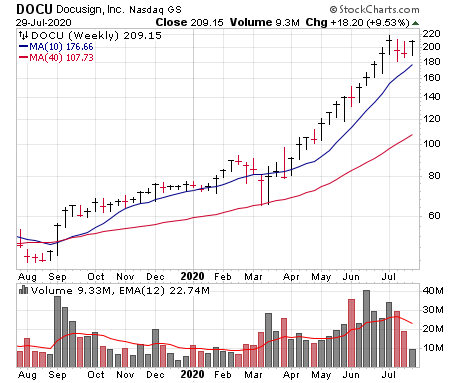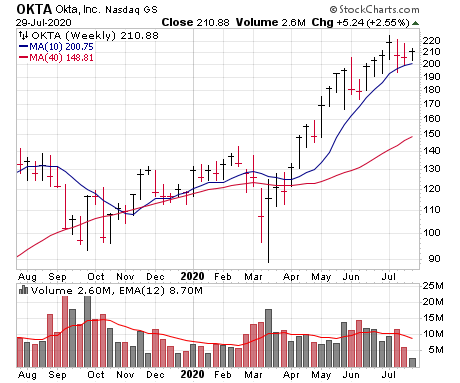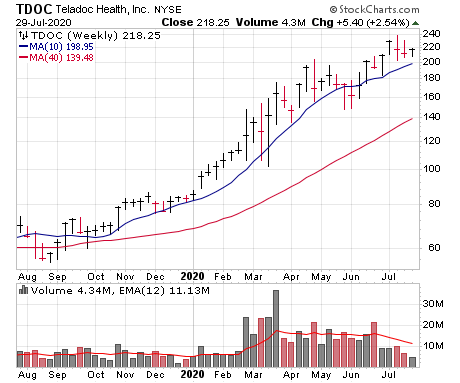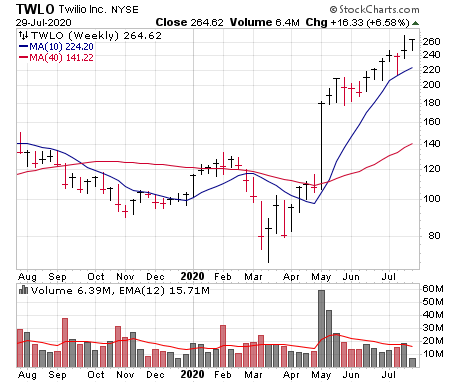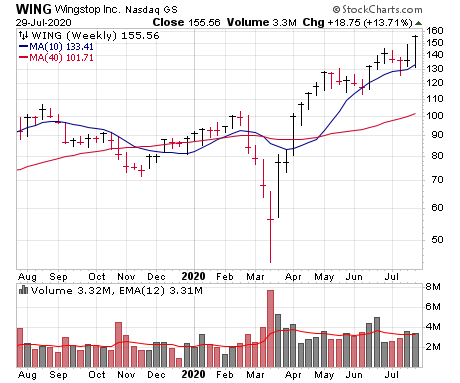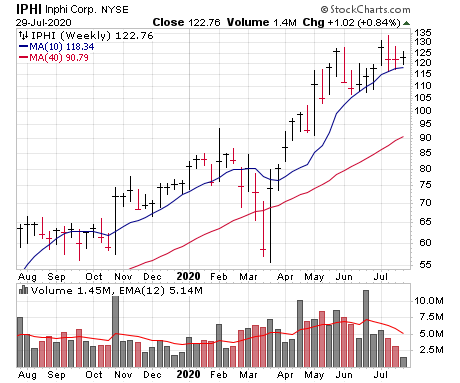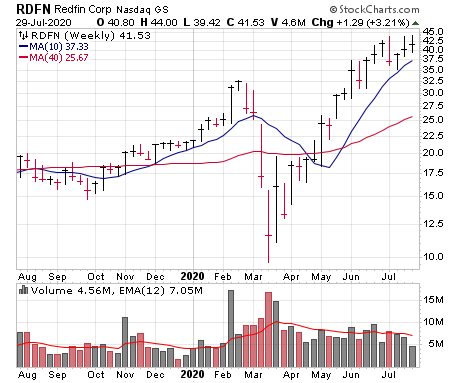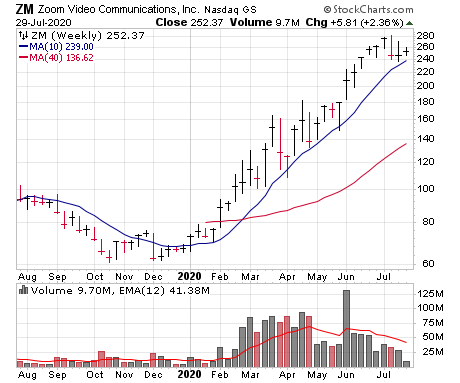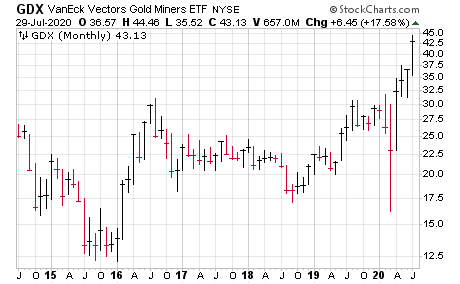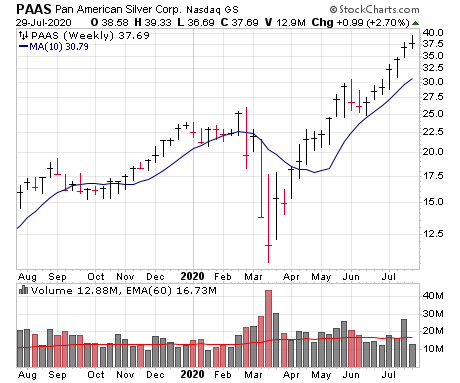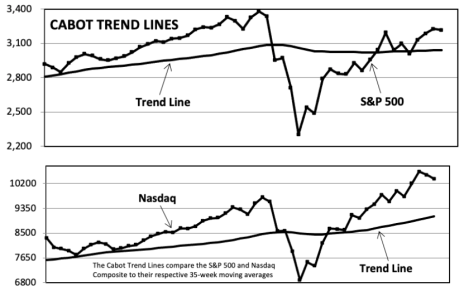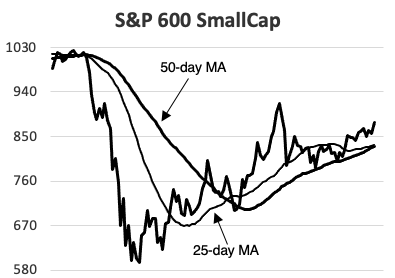The Nasdaq and growth stocks have a lost a little steam since early July, with fewer stocks moving up and the indexes doing more chopping than trending. That’s a good reason to take your foot off the accelerator, but most of the big-picture evidence remains positive, so we’re holding our strong, profitable stocks and remaining mostly bullish.
In tonight’s issue, we review some of that bullish longer-term evidence, talk a bit about gold stocks and, as always, go over our latest thoughts on the stocks we own and are watching.
Cabot Growth Investor 1451
[premium_html_toc post_id="211207"]
Positive, but Less Powerful
One of the big reasons the market has always attracted us is that it’s a contrary beast, requiring investors to think and perceive things differently than in their day-to-day view of the real world. To the average person who turns on the news or their favorite political or financial show, there’s lots to chew over. What does the resurgence of the virus in certain states mean for the economy? What about the upcoming election for President and Congress? How should one balance the continuing partial shut-ins and horrid Q2 GDP number (minus 33%!) with the strong housing sector and loose Fed?
For the market, what about the crazy P/E ratios and the effect of so many zombie industries (airlines, hotels, movie theaters) on the broad market? And what of those Robinhood traders that are piling into news-driven stocks like mad? While having perspective is always a good thing, examining every different angle will usually do more harm than good.
Instead, while uncertainties exist everywhere these days, it’s more important than ever to stay focused on the key evidence. And when you do that, the conclusion is simple: It’s a bull market, with the odds strongly favoring higher prices over time, but near-term, the indexes and many leaders are doing more meandering than trending, which means you should keep your antennae up.
On the first point, we’re impressed that nearly all of the longer-term evidence is positive—our Cabot Trend Lines are clearly bullish, most sentiment measures tell us the man on the street is skeptical and plenty of big-picture studies and indicators tell us higher prices are coming. (See our write-up on our Two-Second Indicator and what it portends later in this issue.)
Near-term, too, most of the vibes are still positive—our Cabot Tides are pointed up, as are the trends of the vast majority of leading stocks—but after a strong run from the lows, we’re beginning to see buying pressures ease, with the Nasdaq finally meeting some resistance since early July and the number of stocks hitting virgin turf slowly drying up during the past three weeks. The up-down-up-down action after a sustained run is also a sign that the sellers are finally putting up a fight.
Thus, as we wrote last week, the music has changed a bit, with the non-stop, jaw-dropping accumulation of growth stocks lightening up, replaced for now by choppier conditions, news-driven (earnings) moves and a decent amount of selling on strength.
What To Do Now
Looking at the entire picture, we think you should stay on the freeway (remain mostly bullish), but it’s prudent to get out of the passing lane and ease off the accelerator (prune a bit and/or tighten mental stops). In the Model Portfolio, we pared back a couple of weeks ago and are still sitting with around 19% in cash and are up handsomely on the year; from here, we’re willing to move in either direction, but tonight we have no changes as we see what earnings season brings.
Model Portfolio Update
We’ve seen a few shots across the bow during the rally, but each one quickly regained strength and lifted to new highs … until now. The big reversal two and a half weeks ago has capped the rally since then, while many growth stocks continue to chop around. Coming after a huge 16-week run, that marks a slight change in character, which is one reason to go slow on the buy side and holding a chunk of cash.
That said, earnings season, which is now in full force, will probably tell the tale—a bunch of breakdowns from leading stocks will have us raising more cash, though so far, we’ve seen plenty of positive reactions. We’re not opposed to doing a little buying, but for the moment, we’re mostly focused on managing our current positions while updating our watch list.
Current Recommendations
| Stock | No. of Shares | Portfolio Weightings | Price Bought | Date Bought | Price on 7/30/20 | Profit | Rating |
| Chegg (CHGG) | 2,401 | 10% | 65 | 5/22/20 | 78 | 21% | Buy |
| Cloudflare (NET) | 5,424 | 11% | 26 | 4/20/20 | 41 | 57% | Buy |
| Dexcom (DXCM) | 290 | 7% | 216 | 11/15/19 | 431 | 100% | Hold |
| DocuSign (DOCU) | 655 | 7% | 65 | 9/13/19 | 214 | 228% | Hold |
| Okta (OKTA) | 632 | 7% | 150 | 4/20/20 | 219 | 46% | Hold |
| ProShares Ultra S&P 500 (SSO) | 1,306 | 10% | 120 | 5/29/20 | 138 | 15% | Buy |
| Teladoc (TDOC) | 631 | 7% | 78 | 11/01/19 | 237 | 203% | Buy |
| Twilio (TWLO) | 830 | 12% | 174 | 5/8/20 | 267 | 54% | Buy |
| Wingstop (WING) | 1,313 | 11% | 128 | 6/19/20 | 159 | 24% | Buy |
| CASH | $339,753 | 19% |
Chegg (CHGG 78)—Similar to the market, CHGG has been up and down during the past three weeks, being rejected in the upper 70s a couple of times. That said, the stock hasn’t done anything wrong, as it holds above its prior high and its 50-day line (both are in the 67 to 68 area), and it’s not like sellers have been able to make much headway (shares are within shouting distance of all-time highs). As with most stocks, Chegg’s quarterly report (likely out in early August) will be key; analysts see revenues up nearly 46% while earnings are expected to rise 39%, but all eyes will be on the firm’s outlook for the back-to-school time period, especially as so many grade schools and colleges appear to be starting the fall offering virtual-heavy education. A bad break on earnings (down into the 60 area) would probably have us cutting the loss and moving on, but right here, the stock looks fine and we think the odds strongly favor the next big move being up. We’ll stay on Buy, but keep new purchases small this close to the likely report. BUY.
Cloudflare (NET 41)—More and more analysts are coming around to our view that, as everything moves online in a hurry, Cloudflare’s unique cloud network is set to be a key cog in this new era as big firms turn to the company for the dependability, security and performance that their web assets and e-commerce offerings need. And the company isn’t resting on its laurels, either; its new Workers Unbound offering is a serverless platform that should be big for developers, while Cloudflare opened up a new office in Tokyo to boost its growth in that area of the world. As for the stock, it’s wobbled this month and looked tired coming into this week, but it didn’t dip much below its 25-day line (above 37 and rising quickly) and has perked up very well in recent days. Given that NET just got moving from an IPO base earlier this year, we’re thinking there are a bunch of funds that will be building positions over time. We’re OK buying some here if you’re not yet in, but with earnings due August 6, keep new positions on the small side. BUY.
Dexcom (DXCM 431)—Dexcom reported Q2 results on Tuesday evening, and the fundamental news was very good; results crushed expectations (revenues up 35% on a constant currency basis, with earnings up nearly 10-fold and more than double official analyst estimates), and management offered a ton of encourging commentary on the conference call: The seeing great growth among intensive Type 2 users (they now make up 20% of U.S. users); for customers using pharmacy benefits (pharmacy is the firm’s fastest-growing sales channel), nearly 70% have out-of-pocket costs of less than $60 per month (including 30% that pay nothing); and Medicare customers have given the G6 rave reviews as customers move away from fingerstick procedures. The stock reacted decently to the report, but not much has changed with the overall chart, as DXCM is still meandering in the 400 to 450 zone and the RP line (not shown) peaked back in mid May. We’re not complacent, and should shares suffer a couple of major waves of selling from here, we could cut back further or sell out completely. However, at this point, any decisive upside power would probably signal the start of DXCM’s next sustained upmove and have us restoring our Buy rating. For now, we’ll simply stay on Hold. HOLD.
DocuSign (DOCU 214)—DOCU was only able to retreat to its 25-day line (now nearing 194 and rising) before bounding back toward its highs, which is a good sign, though to be fair, we’re really we’re not seeing much in the way of big buying or selling in recent weeks (volume has dried up meaningfully). Still, this choppy action could be just what the doctor ordered; another two or three weeks of sideways trading could offer up a solid entry point, and earnings aren’t likely to be released until early September. Fundamentally, there probably aren’t many companies benefiting from the pandemic more than DocuSign; its purchase of tiny Liveoak Technologies earlier this month should accelerate the adoption of its remote online notarization offering, and the refinancing/mortgage/housing recovery should provide a tailwind as so many lenders are now using DocuSign. Back to the stock, we still think the intermediate-term is a 50-50 bet; if you really want in, we’re not against nibbling, but we’ll officially stay on Hold and look for a higher-odds setup. HOLD.
Okta (OKTA 219)—OKTA continues to consolidate above the 200 level, with volume drying up in a big way during the past couple of weeks, though today’s pop is certainly good to see. Our thoughts haven’t changed: Big picture, Okta’s identity security offerings should be a must-have for big, global outfits going forward, and after a “reset” base from mid-2019 through March, we think many big investors are still rebuilding positions. If the stock pushes higher from here (possibly thanks to some positive reports from its peers; FireEye gapped up on earnings this week), we won’t hesitate to go back to Buy, but having just taken partial profits a couple of weeks ago, we’ll stay on Hold for the moment. HOLD.
ProShares Ultra S&P 500 Fund (SSO 138)—SSO isn’t going to be something you brag about at neighborhood get togethers, but it remains in a relatively steady uptrend, and the two big shakeouts in June (both found support near the 10-week line) are likely a good thing in retrospect, shaking free some late buyers. Stepping back, we remain encouraged that the S&P is more or less following the script from the blastoff indicators in late May/early June and their “normal” path; there are never any guarantees, but the longer things follow the general plan, the greater the chance that a prolonged bull move is indeed underway. We think SSO is a solid buy here or on any dips. BUY.
Teladoc (TDOC 237)—Everyone who follows these things knows that virtual health is seeing great growth this year, but Teladoc’s quarterly report still caused plenty of jaws to drop, as the fundamental growth here is borderline stunning. In last night’s Q2 report, the firm revealed that revenues were up 85% (partially due to the acquisition of InTouch, which is expected to grow 35% in 2020), with subscription sales up 64% and visits (and visit-related revenue) more than tripling from a year ago. And there’s a lot more growth coming down the pike—management significantly hiked 2020 and 2021 estimates, with revenues expected to rise 75% or so this year and another 35% in 2021. As we wrote above, it’s always possible TDOC (which broke out around 90 back in early January) has already discounted the foreseeable future. But we don’t see any evidence that the stock is losing steam, as shares never came close to their 50-day line (now near 196 and rising) during the market’s recent ups and downs, and perked up nicely today, threatening all-time highs . All in all, near-term wiggles are certainly possible, but we continue to think higher prices are likely as virtual health goes mainstream. BUY.
Twilio (TWLO 267)—TWLO had a humongous earnings gap back in early May, but despite the move, it’s been unable to pull in for more than a couple of days at a time (it’s found support at or above its 25-day line numerous times since then; that line is currently at 239 and rising), which goes along with our view that the stock is in the early innings of what should be a bigger advance. Obviously, at some point, shares will have a “real” correction that lasts a few weeks, possibly after earnings next Tuesday (August 4); analysts are looking for revenues to rise 34% and a loss of nine cents per share, though as always, the outlook will be key. Still, while anything is possible (stay flexible!), given Twilio’s centrality to so many emerging trends (programmable voice, texts, emails and video; cloud contact centers; powering telehealth solutions, etc.), we’re thinking the odds of further upside are high. Our Buy rating stands, but like our other names reporting earnings soon, keep any new positions small this close to the report. BUY.
Wingstop (WING 159)—WING has been choppy in recent weeks, but the firm’s earnings report Wednesday morning brought in a rush of buying. In Q2, Wingstop’s revenue leapt a huge 36% from a year ago, while EBITDA (often a better measure of cash flow than earnings for a company like this) lifted 54% and digital orders made up nearly 64% of the total. The sub-metrics were also excellent (domestic same-store sales up a ridiculous 32%!), and the store opening plan remains on track (store count up 10% in Q2; 120 to 130 new store openings for 2020 as a whole). The stock went ballistic on the news, surging to new high as the earnings power of the company looks set to get much larger both in the short-term (the firm is well positioned whether there are virus shut-ins or not) and longer-term (as the company greatly expands its store count both in the U.S. and overseas). Now, the stock is not a go-go name, so we don’t expect a straight-up advance, but there’s no doubt the path of least resistance is up. BUY.
Watch List
- Bill.com (BILL 92): BILL has been up, down and all around, but it’s now close to new highs after a couple of months of consolidation. It’s a bit squiggly, but we could take a swing at it if it continues to act well. Earnings aren’t due until August 27.
- Datadog (DDOG 93): Like most growth stocks, DDOG has rested over the past three weeks, but it’s holding its 50-day line and the story is as good as it gets. Earnings are due out a week from today (August 6).
- Inphi (IPHI 127): IPHI has been bobbing and weaving for nine weeks as earnings (due out August 4) approach. See more below.
- Redfin (RDFN 43): RDFN is our favorite play on the burgeoning housing market, with a legit growth story to go along with an industry resurgence. Earnings are due out tonight. See more below.
- Spotify (SPOT 261): SPOT has been pulling back some, but the overall uptrend is very much intact. Shares could need more time to rest and set up, but we continue to be very high on SPOT’s potential.
Other Stocks of Interest
The stocks below may not be followed in Cabot Growth Investor on a regular basis. They’re intended to present you with ideas for additional investment beyond the Model Portfolio. For our current ratings on these stocks, see Updates on Other Stocks of Interest on the subscriber website or email mike@cabotwealth.com.
Inphi (IPHI 127)—We owned Inphi for a while last year and early this year (made some decent money) and have been waiting for an opportunity to get back in—and depending how earnings go next week (August 4 before the opening bell), that time could be soon. For a networking-type story, it really doesn’t get better than Inphi’s as it looks like rapid, reliable growth is nearly a sure thing for at least the next couple of years. The firm is the hands-down leader in high-speed data interconnects (both in terms of market share and performance), with demand spiking thanks to upgrade cycles and the new reality that will have millions more people working, learning and playing from home even after the pandemic. First is the company’s products that speed up things within data centers; hyperscale cloud operators like Amazon and Google are gobbling up the firm’s digital signal processors as they upgrade their networks, with others like Alibaba likely to do so in the months ahead. Analysts see Inphi as two full years ahead of the competition in this area, with a market share in the 65%-plus range! Then comes Inphi’s product that connects data centers to each other—dubbed ColorZ, it’s seeing a big pickup in demand thanks to its partnership with Microsoft, which is using it to connect its new data centers to each other all over world, and which inked a massive contract with the Dept. of Defense for cloud initiatives. Just a bit down the road, Inphi’s next-generation ColorZ will offer better performance and connecting at longer distances, which should allow for 30%-plus growth in this field for a few years. Throw in leverage to 5G and other broader networking trends and the company should be drive sales and earnings nicely higher at least through next year, with plenty upside beyond that. Back to the chart, IPHI had a fantastic run right from its crash lows all the way to 128 in May, but since then it’s effectively rested for about nine weeks as earnings approach. A solid reaction could have us stepping in.
Redfin (RDFN 43)—During the last economic upcycle, housing construction was a distinct laggard as the industry slowly recovered from the bubble and bust that preceded it. But could this post-pandemic expansion see housing return to its former glory? We think it’s possible, thanks to years of below-average building, rising prices and ridiculous low mortgage rates. Many homebuilding stocks look great (LGI Homes (LGIH) appears to be the leader there), but as always, we’re more interested in a growthier play, and Redfin is our favorite. The story here is about using technology (data analytics really), a popular website (33 million monthly average visitors as of February; four times higher than the next largest brokerage website) and (thanks to the advantages of the first two) lower commissions (save 1% on the sale of your house, and more if you both buy and sell through Redfin) to form a dominant nationwide brokerage firm. Most importantly, the results for customers have been solid, with faster sales and better prices attained than competing brokerage firms. That’s helped Redfin consistently gain market share—in Q1 2017, it sold 0.73% of all existing homes (by value) across the U.S.; in Q1 2018, that leapt to 0.83%; and in Q1 of this year, up to 0.93%! The company also does some direct home buying (like Zillow), which is another growth avenue, but it’s the brokerage aspect that is the driver. Big picture, technology is finally revolutionizing the housing industry, and Redfin is the leader in that movement; the combination of an industry boom and rising market share means Redfin should get much larger over time. As for the stock, it appeared to get going earlier this year, but the crash poured cold water on that. But the recovery from there has been extremely persistent, and the stock’s recent pullback to the 10-week line brought in a rush of buyers. We’ll see what earnings bring tonight (July 30).
Zoom Video (ZM 250)—We greatly prefer stocks that are just a month or two into their runs and aren’t well known by most investors … and that doesn’t fit with Zoom Video, the highly popular video conferencing firm that has become a household name during the pandemic. Thus, it’s a higher-risk situation (any disappointment could send late buyers scurrying away). But ZM has clearly been one of the real leading stocks of the year, and the recent pullback toward its 10-week line is intriguing. The story, of course, is about as good as it gets; while Zoom has had some issues (including security worries), it’s still by far the top in mindshare in the industry. And the numbers have been astounding—even with high expectations, Q1 figures (quarter ending April 30) crushed expectations, with revenues rising 169%, earnings up seven-fold and the sub-metrics wowing (customers with at least 10 employees up 354%, same-customer revenue growth north of 30% for the eighth straight quarter). And management didn’t hold back, either, nearly doubling their forecast for the rest of the year (analysts see full-year revenues up 190%). The question here is whether this proves to be a one-time, step-function move higher that’s already been discounted, or whether the move toward “video everything” is long lasting. The market seems to believe the latter (as do we), which means even the current estimates (sales up 190% this year, but only 25% in 2021) could prove conservative. If you want to take a swing at ZM, we think the current pullback is an opportunity, though a decisive break of the 50-day line (now at 233 and rising) would probably tell you the stock needs a deeper, longer consolidation.
New Lows Continue to Paint an Encouraging Picture
There’s no question that it’s been a divergent environment the past few months, with the Nasdaq and leading growth stocks acting well while the broad market has done just OK. And that’s led to a barrage of articles and opinions about how unsustainable the uptrend is, especially given all that’s going on in the world.
To be fair, we are flexible, and given some of the evidence out there (including the time factor, which we wrote about in the last issue), we have raised a little cash lately; the market and leading stocks have certainty earned the right to consolidate for a while if they want to. But we’re still longer-term bullish for a few reasons, and one of them revolves around the number of stocks hitting new lows on the NYSE (our old Two-Second Indicator), which measure the broad market’s health.
One measure we like to look at is an intermediate-term view (50-day moving average) of the percent of all NYSE stocks hitting new lows. (For example: 40 new lows with 4,000 stocks traded would mean 1% of issues hit new lows on the day; those figures are then averaged over 50 days.) It’s hard to get a good-looking chart of this, but take our word for it that, during this year’s crash, the 50-day average of new lows rose to more than 13% (!) of all issues before plummeting to below 0.5% in mid-June.
The important point is that this pattern—a huge selling crescendo leading to massive amounts of new lows (we used the 50-day average over 5% as the demarcation line), followed by very tame readings (the 50-day average dipping below 0.5% within six to nine months of the selling peak)—is typically seen near solid market lows that spawn great advances. By our measures, it’s only happened nine other times during the past 40 years. Some examples:
In the fall of 1990, the 50-day average of new lows reached nearly 10% during the pre-Gulf War bear phase, but that all changed by the end of the following March, when the reading dipped below 0.5%. From that point, the Nasdaq rallied as much as 30% over the following year.
A mini-bear phase in 1994 was very rough for the broad market; the 50-day percentage of new lows was north of 5% at year-end. But in 1995 the market completely changed character, with the percentage dipping below 0.5% by June. Once again, the Nasdaq rallied as much as 30% within 12 months of that signal.
The kickoff to the 2009 bull market was similar, with plus-5% readings still in effect in March, but the average plummeted beneath 0.5% by the end of May (one of the fastest turnarounds we’ve seen). The maximum gain over the next year was north of 40%.
Of course, not every signal was as fruitful as these. The February 2012 green light saw just a 7% max gain during the next 12 months for the Nasdaq, while the most recent signal (April 2016) brought a ton of choppy pre-election action before finally taking off. Even the March 1988 signal (after the 1987 crash) was just OK. Interestingly, though, all three of these laggards saw big gains just outside of the one-year window. Moreover, even including the so-so signals, the average max gain during the 12 months following these signals was nearly 30% on the Nasdaq. (So far, this year’s signal is up as much as 10%.)
Beyond the exact returns, though, is just recognizing the power of the general pattern. Despite the worries over the divergence, the fact that we already had a massive crash and are now seeing a long, sustained period of very few stocks hitting new lows has historically been a very good thing when looking out a year or more.
There’s No Fever Like Gold Fever
We believe it was the late Richard Russell who coined the above phrase, and that’s especially true today, as gold and other precious metals have broken out on the upside as investors think inflation could be around the bend with all the stimulus being thrown around. We’ll never say never, but it’s unlikely we’ll dive into a gold stock in the Model Portfolio; at this time, there are too many growth stocks to choose from, and besides, straight commodity stocks tend not to adhere to the chart rules and tools we have in place.
Still, we’re practical, and after a deep correction and consolidation over the past few years, gold stocks have gotten going in a big way. If you’re interested, you can always just play the VanEck Gold Miners Fund (GDX), which tracks the group and is freewheeling on the upside. (Monthly chart shown below.)
If you’re looking for an individual name, Pan American Silver (PAAS) looks like one of the real leaders of the group. Despite the name, its buyout of Tahoe Resources early last year means it’s doing more business in gold than in silver (though it has lots of exposure to both). While COVID concerns still linger in certain areas (it has mines all over the world), many of its operations have restarted in Mexico and its Canadian mines are still seeing output crank ahead. Analysts see a hiccup this year but see earnings soaring more than 150% in 2021 as production increases and higher prices are realized. Buying on dips would be preferable, especially with earnings due out August 5.
Cabot Market Timing Indicators
The Nasdaq and growth stocks have hit some resistance for the first time in months. Near-term, that’s something to note, but it’s far from a red flag—right now, most leaders remain in good shape and the trends of the major indexes remain up. We wouldn’t go overboard on the buy side but we remain overall bullish.
Cabot Trend Lines: Bullish
Our Cabot Trend Lines have hesitated a bit during the past couple of weeks, but this big-picture indicator remains firmly bullish—as of last Friday’s close, both the S&P 500 (by 5.7%) and Nasdaq Composite (by a huge 14.3%) remained well above their respective 35-week moving averages. That keeps the longer-term trend pointed up, telling us that the odds favor higher prices over time.
Cabot Tides: Bullish
While the Nasdaq has met with some selling since early July, the rotation into the broad market has helped our Cabot Tides remain bullish, with most broader indexes (including the S&P 600 SmallCap, shown here) perking up a bit. And there’s more daylight too, as it would take a 5%-ish drop from here to put the Tides back on the fence. All told, both the intermediate- and longer-term trends are pointed up, which is reason enough to stay mostly bullish.
Cabot Real Money Index: Neutral
Our Real Money Index has gyrated during the past couple of weeks but net-net, the five-week sum of money flows is still in the middle of its range for the past year or so. There’s certainly no enthusiasm (in fact, money has drained out of equity funds 10 of the past 12 weeks!), but there hasn’t been any clear stampede to the exits that would mark a more sustainable contrary indication.
Charts courtesy of StockCharts.com
The next Cabot Growth Investor issue will be published on August 13, 2020.
Cabot Wealth Network
Publishing independent investment advice since 1970.
CEO & Chief Investment Strategist: Timothy Lutts
President & Publisher: Ed Coburn
176 North Street, PO Box 2049, Salem, MA 01970 USA
800-326-8826 | support@cabotwealth.com | CabotWealth.com
Copyright © 2020. All rights reserved. Copying or electronic transmission of this information is a violation of copyright law. For the protection of our subscribers, copyright violations will result in immediate termination of all subscriptions without refund. No Conflicts: Cabot Wealth Network exists to serve you, our readers. We derive 100% of our revenue, or close to it, from selling subscriptions to its publications. Neither Cabot Wealth Network nor our employees are compensated in any way by the companies whose stocks we recommend or providers of associated financial services. Disclaimer: Sources of information are believed to be reliable but they are not guaranteed to be complete or error-free. Recommendations, opinions or suggestions are given with the understanding that subscribers acting on information assume all risks involved. Buy/Sell Recommendations: All recommendations are made in regular issues or email alerts or updates and posted on the private subscriber web page. Performance: The performance of this portfolio is determined using the midpoint of the high and low on the day following the recommendation. Cabot’s policy is to sell any stock that shows a loss of 20% in a bull market or 15% in a bear market from the original purchase price, calculated using the current closing price. Subscribers should apply loss limits based on their own personal purchase prices.

